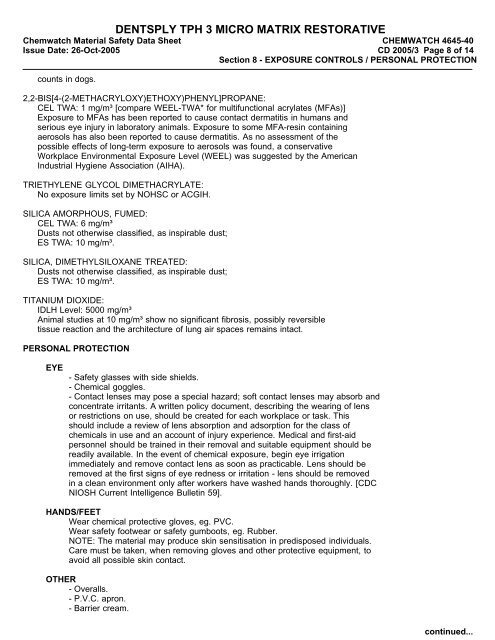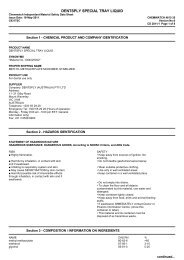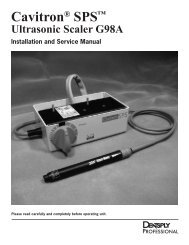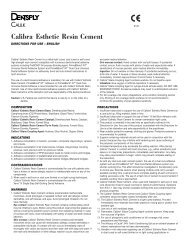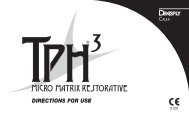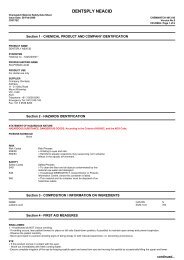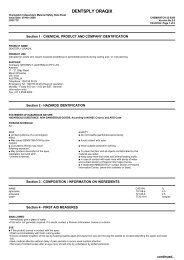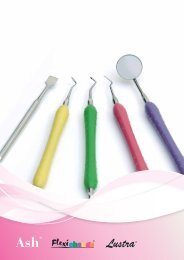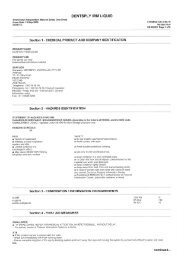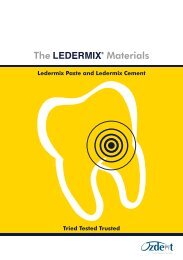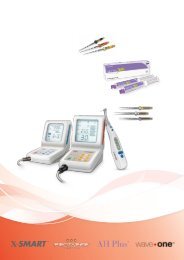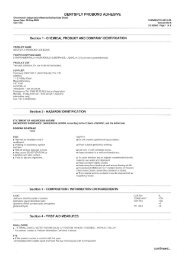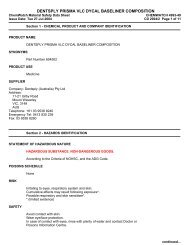dentsply tph 3 micro matrix restorative
dentsply tph 3 micro matrix restorative
dentsply tph 3 micro matrix restorative
You also want an ePaper? Increase the reach of your titles
YUMPU automatically turns print PDFs into web optimized ePapers that Google loves.
DENTSPLY TPH 3 MICRO MATRIX RESTORATIVE<br />
Chemwatch Material Safety Data Sheet CHEMWATCH 4645-40<br />
Issue Date: 26-Oct-2005 CD 2005/3 Page 8 of 14<br />
Section 8 - EXPOSURE CONTROLS / PERSONAL PROTECTION<br />
counts in dogs.<br />
2,2-BIS[4-(2-METHACRYLOXY)ETHOXY)PHENYL]PROPANE:<br />
CEL TWA: 1 mg/m³ [compare WEEL-TWA* for multifunctional acrylates (MFAs)]<br />
Exposure to MFAs has been reported to cause contact dermatitis in humans and<br />
serious eye injury in laboratory animals. Exposure to some MFA-resin containing<br />
aerosols has also been reported to cause dermatitis. As no assessment of the<br />
possible effects of long-term exposure to aerosols was found, a conservative<br />
Workplace Environmental Exposure Level (WEEL) was suggested by the American<br />
Industrial Hygiene Association (AIHA).<br />
TRIETHYLENE GLYCOL DIMETHACRYLATE:<br />
No exposure limits set by NOHSC or ACGIH.<br />
SILICA AMORPHOUS, FUMED:<br />
CEL TWA: 6 mg/m³<br />
Dusts not otherwise classified, as inspirable dust;<br />
ES TWA: 10 mg/m³.<br />
SILICA, DIMETHYLSILOXANE TREATED:<br />
Dusts not otherwise classified, as inspirable dust;<br />
ES TWA: 10 mg/m³.<br />
TITANIUM DIOXIDE:<br />
IDLH Level: 5000 mg/m³<br />
Animal studies at 10 mg/m³ show no significant fibrosis, possibly reversible<br />
tissue reaction and the architecture of lung air spaces remains intact.<br />
PERSONAL PROTECTION<br />
EYE<br />
- Safety glasses with side shields.<br />
- Chemical goggles.<br />
- Contact lenses may pose a special hazard; soft contact lenses may absorb and<br />
concentrate irritants. A written policy document, describing the wearing of lens<br />
or restrictions on use, should be created for each workplace or task. This<br />
should include a review of lens absorption and adsorption for the class of<br />
chemicals in use and an account of injury experience. Medical and first-aid<br />
personnel should be trained in their removal and suitable equipment should be<br />
readily available. In the event of chemical exposure, begin eye irrigation<br />
immediately and remove contact lens as soon as practicable. Lens should be<br />
removed at the first signs of eye redness or irritation - lens should be removed<br />
in a clean environment only after workers have washed hands thoroughly. [CDC<br />
NIOSH Current Intelligence Bulletin 59].<br />
HANDS/FEET<br />
Wear chemical protective gloves, eg. PVC.<br />
Wear safety footwear or safety gumboots, eg. Rubber.<br />
NOTE: The material may produce skin sensitisation in predisposed individuals.<br />
Care must be taken, when removing gloves and other protective equipment, to<br />
avoid all possible skin contact.<br />
OTHER<br />
- Overalls.<br />
- P.V.C. apron.<br />
- Barrier cream.<br />
continued...


